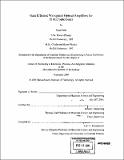| dc.contributor.advisor | Lionel C. Kimerling. | en_US |
| dc.contributor.author | Saini, Sajan, 1973- | en_US |
| dc.contributor.other | Massachusetts Institute of Technology. Dept. of Materials Science and Engineering. | en_US |
| dc.date.accessioned | 2005-09-27T18:52:24Z | |
| dc.date.available | 2005-09-27T18:52:24Z | |
| dc.date.copyright | 2004 | en_US |
| dc.date.issued | 2004 | en_US |
| dc.identifier.uri | http://hdl.handle.net/1721.1/28885 | |
| dc.description | Thesis (Ph. D.)--Massachusetts Institute of Technology, Dept. of Materials Science and Engineering, 2004. | en_US |
| dc.description | Includes bibliographical references (p. 288-294). | en_US |
| dc.description.abstract | (cont.) Er-based gain. We reported the first infrared photoluminescence PL study of Er₂O₃ and found a 7 ms lifetime at 4 K, attributed to a metastable FCC or HCP phase. We showed the thermodynamically stable BCC crystal phase has PL emission lines at 1537 nm and 1550 nm, and metastable FCC and HCP crystal phases result in PL emission lines at 1542 nm and 1533 nm. Upconversion coefficient measurements on the BCC phase and 7 ms lifetime metastable phase gave values of 10⁻¹⁷ and 10⁻¹⁸ cm³/s, respectively. Comparison of room temperature absorption versus 4 K PL of Er₂O₃ and an SiO₂:Er reference showed the BCC phase to be the dominant volume fraction. The calculated WOA power requirements for 3 dB gain in the metastable phase were found to be 450 mW. We examined SiON and Si₃N₄ for high index difference ([delta]n=0.1-0.7) Er host materials. Samples were grown by sputtering, and we investigated the optical materials quality of this process by studying sputtered SiO₂:Er; we report a record co-sputtered SiO₂:Er room temperature lifetime of 14 ms. PL versus heat treatment results strongly indicate the nitride environment of Si₃N₄ favors a higher Er solubility and lower cooperative upconversion than the oxide environment of SiO₂. We measure a 2.4 ms radiative lifetime in co-sputtered Si₃N₄:Er, [approximately] 4x smaller than radiative lifetime reports in ion implanted Si₃N₄:Er PL samples; we attribute this enhancement to an optimized Er ligand field from the sputter process ... | en_US |
| dc.description.abstract | Si Microphotonics is a micron-scale planar processing technology compatible with the fabrication tools of Si Microelectronics. The first demonstration of an integrated set of microphotonic devices replicating the function of an entire fiber optic link, dubbed a Planar Lightwave Circuit (PLC), is being developed to solve the Integrated Circuit (IC) interconnection bottleneck problem: the project proposes replacing time delaying metal interconnects with optical interconnects, i.e. a PLC integrated onto the IC chip. This work requires the development of compact micron-scale analogs to fiber optic link device elements. In this thesis, we take example from commercially available Erbium Doped Waveguide Amplifiers (EDWAs), to investigate the use of high Er concentration doped materials and device design optimization to create gain efficient Waveguide Optical Amplifiers (WOA) in the PLC, at 1.55 [micro]m light. We develop a waveguide index difference An scaling methodology with which to optimally design a WOA into as small a planar footprint as possible and using as little optical pump power as required. We observe that device gain efficiency and footprint have a power-law dependence, summarized in a cumulative Figure-of-Merit, of [delta]n²·⁶. This strong improvement in WOA performance is dependent on the requirement of strip waveguide propagation losses < 0.2 dB/cm, a requirement demonstrated in SiON waveguides. We conclude that a 10 mW-powered 3 dB or 30 dB gain WOA can be fit into a 425x425 [micro]m² or 3x3 mm² footprint, respectively, using an SiON [delta]n=0.155 Er-doped strip waveguide. The impact of [delta]n scaling shows the WOA to be feasible for dense PLCs and low cost planar EDWAs. We examined Er₂O₃ as a materials candidate for ultra-high | en_US |
| dc.description.statementofresponsibility | by Sajan Saini. | en_US |
| dc.format.extent | 294 p. | en_US |
| dc.format.extent | 16077679 bytes | |
| dc.format.extent | 16117030 bytes | |
| dc.format.mimetype | application/pdf | |
| dc.format.mimetype | application/pdf | |
| dc.language.iso | en_US | |
| dc.publisher | Massachusetts Institute of Technology | en_US |
| dc.rights | M.I.T. theses are protected by copyright. They may be viewed from this source for any purpose, but reproduction or distribution in any format is prohibited without written permission. See provided URL for inquiries about permission. | en_US |
| dc.rights.uri | http://dspace.mit.edu/handle/1721.1/7582 | |
| dc.subject | Materials Science and Engineering. | en_US |
| dc.title | Gain effect waveguide optical amplifiers for Si microphotonics | en_US |
| dc.type | Thesis | en_US |
| dc.description.degree | Ph.D. | en_US |
| dc.contributor.department | Massachusetts Institute of Technology. Department of Materials Science and Engineering | |
| dc.identifier.oclc | 60426440 | en_US |

